Financial Decision Making Analysis Report for SKANSKA PLC
VerifiedAdded on 2022/12/12
|10
|3390
|264
Report
AI Summary
This report provides a comprehensive analysis of financial decision-making, focusing on the case of SKANSKA PLC. It begins with an introduction highlighting the critical role of financial decision-making in today's competitive market. The report then delves into the detailed identification and evaluation of the functions, roles, and duties of accounting and finance departments within the company. It examines the functions of accountants in maintaining accurate records and the responsibilities of finance managers in cash flow management and strategic planning. The report further analyzes and evaluates the facts and figures of the company, including key financial ratios such as Return on Capital Employed (ROCE), Net Profit Margin, and Current Ratio. The analysis includes the calculation of these ratios for 2018 and 2019, along with interpretations of the company's performance and the factors influencing the results. The report concludes by summarizing the key findings and implications for SKANSKA PLC's financial strategy and future performance.

Financial decision
making
making
Paraphrase This Document
Need a fresh take? Get an instant paraphrase of this document with our AI Paraphraser
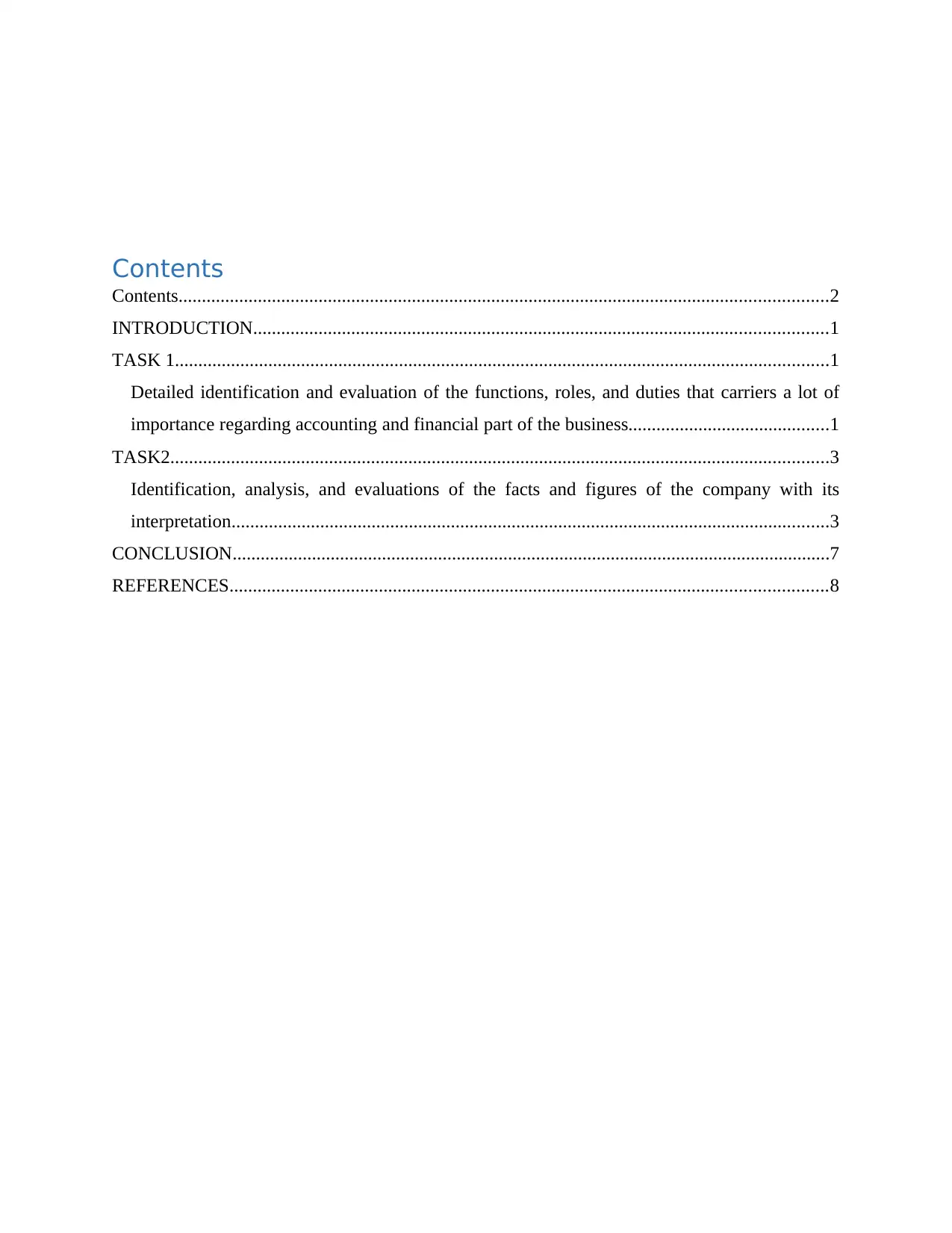
Contents
Contents...........................................................................................................................................2
INTRODUCTION...........................................................................................................................1
TASK 1............................................................................................................................................1
Detailed identification and evaluation of the functions, roles, and duties that carriers a lot of
importance regarding accounting and financial part of the business...........................................1
TASK2.............................................................................................................................................3
Identification, analysis, and evaluations of the facts and figures of the company with its
interpretation................................................................................................................................3
CONCLUSION................................................................................................................................7
REFERENCES................................................................................................................................8
Contents...........................................................................................................................................2
INTRODUCTION...........................................................................................................................1
TASK 1............................................................................................................................................1
Detailed identification and evaluation of the functions, roles, and duties that carriers a lot of
importance regarding accounting and financial part of the business...........................................1
TASK2.............................................................................................................................................3
Identification, analysis, and evaluations of the facts and figures of the company with its
interpretation................................................................................................................................3
CONCLUSION................................................................................................................................7
REFERENCES................................................................................................................................8
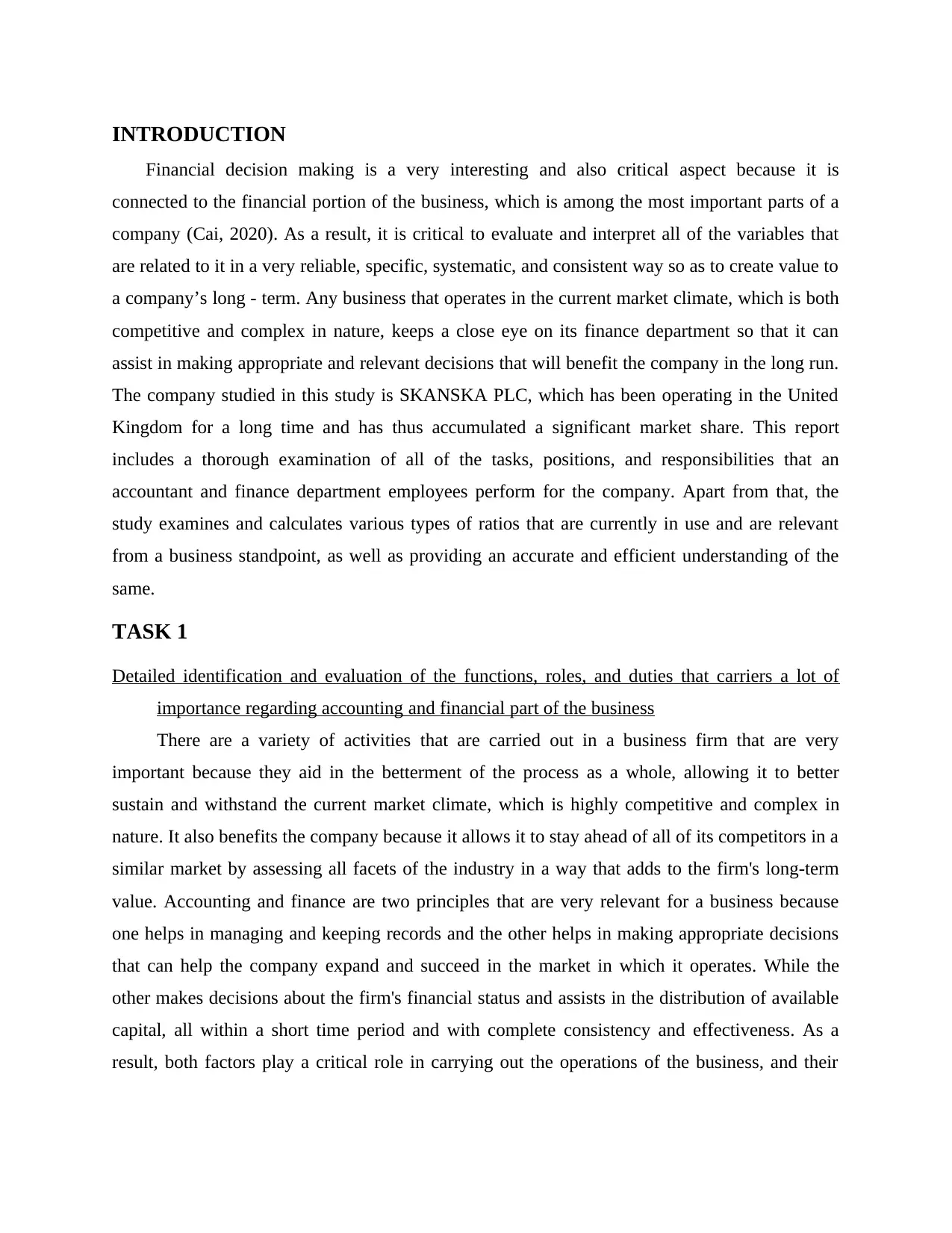
INTRODUCTION
Financial decision making is a very interesting and also critical aspect because it is
connected to the financial portion of the business, which is among the most important parts of a
company (Cai, 2020). As a result, it is critical to evaluate and interpret all of the variables that
are related to it in a very reliable, specific, systematic, and consistent way so as to create value to
a company’s long - term. Any business that operates in the current market climate, which is both
competitive and complex in nature, keeps a close eye on its finance department so that it can
assist in making appropriate and relevant decisions that will benefit the company in the long run.
The company studied in this study is SKANSKA PLC, which has been operating in the United
Kingdom for a long time and has thus accumulated a significant market share. This report
includes a thorough examination of all of the tasks, positions, and responsibilities that an
accountant and finance department employees perform for the company. Apart from that, the
study examines and calculates various types of ratios that are currently in use and are relevant
from a business standpoint, as well as providing an accurate and efficient understanding of the
same.
TASK 1
Detailed identification and evaluation of the functions, roles, and duties that carriers a lot of
importance regarding accounting and financial part of the business
There are a variety of activities that are carried out in a business firm that are very
important because they aid in the betterment of the process as a whole, allowing it to better
sustain and withstand the current market climate, which is highly competitive and complex in
nature. It also benefits the company because it allows it to stay ahead of all of its competitors in a
similar market by assessing all facets of the industry in a way that adds to the firm's long-term
value. Accounting and finance are two principles that are very relevant for a business because
one helps in managing and keeping records and the other helps in making appropriate decisions
that can help the company expand and succeed in the market in which it operates. While the
other makes decisions about the firm's financial status and assists in the distribution of available
capital, all within a short time period and with complete consistency and effectiveness. As a
result, both factors play a critical role in carrying out the operations of the business, and their
Financial decision making is a very interesting and also critical aspect because it is
connected to the financial portion of the business, which is among the most important parts of a
company (Cai, 2020). As a result, it is critical to evaluate and interpret all of the variables that
are related to it in a very reliable, specific, systematic, and consistent way so as to create value to
a company’s long - term. Any business that operates in the current market climate, which is both
competitive and complex in nature, keeps a close eye on its finance department so that it can
assist in making appropriate and relevant decisions that will benefit the company in the long run.
The company studied in this study is SKANSKA PLC, which has been operating in the United
Kingdom for a long time and has thus accumulated a significant market share. This report
includes a thorough examination of all of the tasks, positions, and responsibilities that an
accountant and finance department employees perform for the company. Apart from that, the
study examines and calculates various types of ratios that are currently in use and are relevant
from a business standpoint, as well as providing an accurate and efficient understanding of the
same.
TASK 1
Detailed identification and evaluation of the functions, roles, and duties that carriers a lot of
importance regarding accounting and financial part of the business
There are a variety of activities that are carried out in a business firm that are very
important because they aid in the betterment of the process as a whole, allowing it to better
sustain and withstand the current market climate, which is highly competitive and complex in
nature. It also benefits the company because it allows it to stay ahead of all of its competitors in a
similar market by assessing all facets of the industry in a way that adds to the firm's long-term
value. Accounting and finance are two principles that are very relevant for a business because
one helps in managing and keeping records and the other helps in making appropriate decisions
that can help the company expand and succeed in the market in which it operates. While the
other makes decisions about the firm's financial status and assists in the distribution of available
capital, all within a short time period and with complete consistency and effectiveness. As a
result, both factors play a critical role in carrying out the operations of the business, and their
⊘ This is a preview!⊘
Do you want full access?
Subscribe today to unlock all pages.

Trusted by 1+ million students worldwide
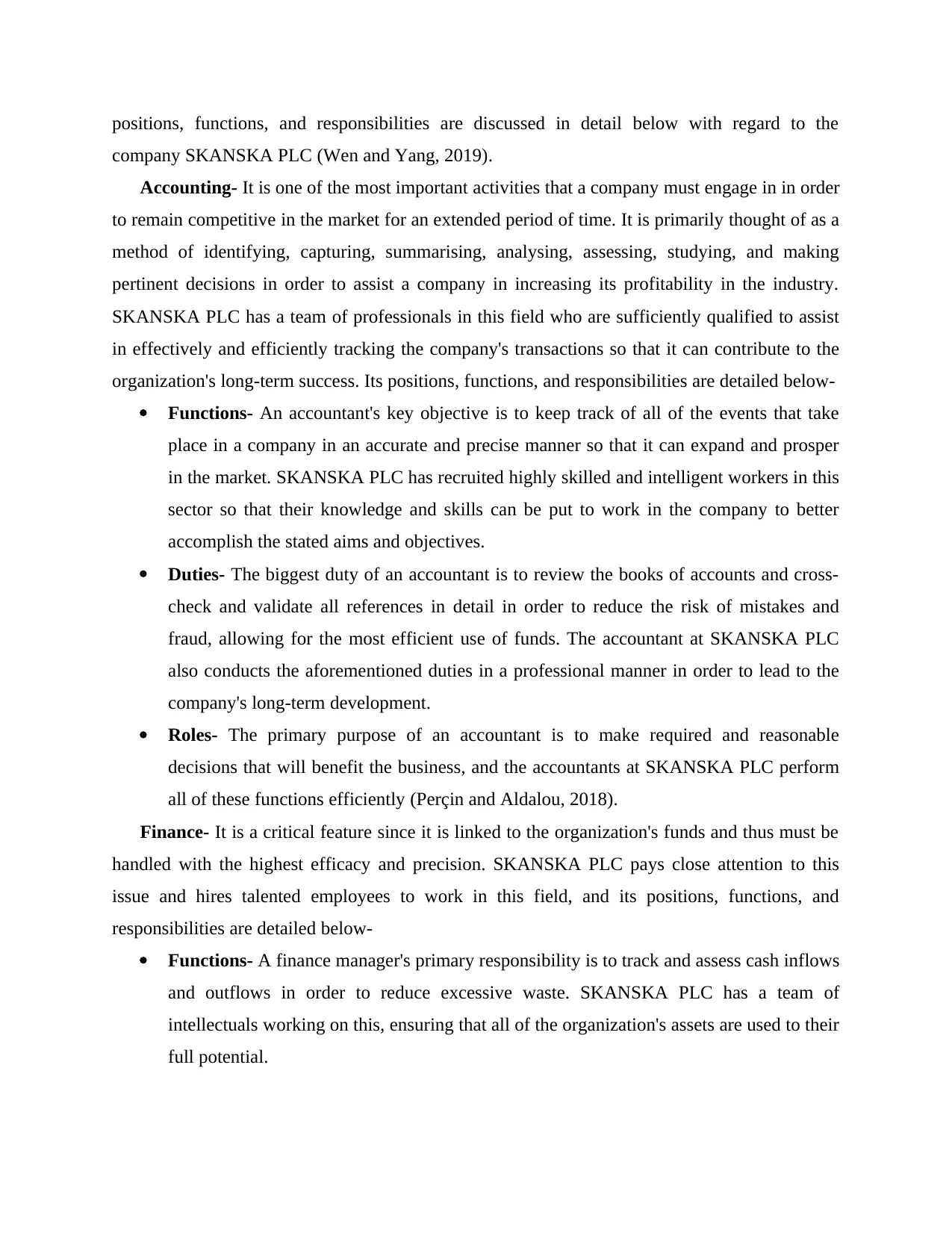
positions, functions, and responsibilities are discussed in detail below with regard to the
company SKANSKA PLC (Wen and Yang, 2019).
Accounting- It is one of the most important activities that a company must engage in in order
to remain competitive in the market for an extended period of time. It is primarily thought of as a
method of identifying, capturing, summarising, analysing, assessing, studying, and making
pertinent decisions in order to assist a company in increasing its profitability in the industry.
SKANSKA PLC has a team of professionals in this field who are sufficiently qualified to assist
in effectively and efficiently tracking the company's transactions so that it can contribute to the
organization's long-term success. Its positions, functions, and responsibilities are detailed below-
Functions- An accountant's key objective is to keep track of all of the events that take
place in a company in an accurate and precise manner so that it can expand and prosper
in the market. SKANSKA PLC has recruited highly skilled and intelligent workers in this
sector so that their knowledge and skills can be put to work in the company to better
accomplish the stated aims and objectives.
Duties- The biggest duty of an accountant is to review the books of accounts and cross-
check and validate all references in detail in order to reduce the risk of mistakes and
fraud, allowing for the most efficient use of funds. The accountant at SKANSKA PLC
also conducts the aforementioned duties in a professional manner in order to lead to the
company's long-term development.
Roles- The primary purpose of an accountant is to make required and reasonable
decisions that will benefit the business, and the accountants at SKANSKA PLC perform
all of these functions efficiently (Perçin and Aldalou, 2018).
Finance- It is a critical feature since it is linked to the organization's funds and thus must be
handled with the highest efficacy and precision. SKANSKA PLC pays close attention to this
issue and hires talented employees to work in this field, and its positions, functions, and
responsibilities are detailed below-
Functions- A finance manager's primary responsibility is to track and assess cash inflows
and outflows in order to reduce excessive waste. SKANSKA PLC has a team of
intellectuals working on this, ensuring that all of the organization's assets are used to their
full potential.
company SKANSKA PLC (Wen and Yang, 2019).
Accounting- It is one of the most important activities that a company must engage in in order
to remain competitive in the market for an extended period of time. It is primarily thought of as a
method of identifying, capturing, summarising, analysing, assessing, studying, and making
pertinent decisions in order to assist a company in increasing its profitability in the industry.
SKANSKA PLC has a team of professionals in this field who are sufficiently qualified to assist
in effectively and efficiently tracking the company's transactions so that it can contribute to the
organization's long-term success. Its positions, functions, and responsibilities are detailed below-
Functions- An accountant's key objective is to keep track of all of the events that take
place in a company in an accurate and precise manner so that it can expand and prosper
in the market. SKANSKA PLC has recruited highly skilled and intelligent workers in this
sector so that their knowledge and skills can be put to work in the company to better
accomplish the stated aims and objectives.
Duties- The biggest duty of an accountant is to review the books of accounts and cross-
check and validate all references in detail in order to reduce the risk of mistakes and
fraud, allowing for the most efficient use of funds. The accountant at SKANSKA PLC
also conducts the aforementioned duties in a professional manner in order to lead to the
company's long-term development.
Roles- The primary purpose of an accountant is to make required and reasonable
decisions that will benefit the business, and the accountants at SKANSKA PLC perform
all of these functions efficiently (Perçin and Aldalou, 2018).
Finance- It is a critical feature since it is linked to the organization's funds and thus must be
handled with the highest efficacy and precision. SKANSKA PLC pays close attention to this
issue and hires talented employees to work in this field, and its positions, functions, and
responsibilities are detailed below-
Functions- A finance manager's primary responsibility is to track and assess cash inflows
and outflows in order to reduce excessive waste. SKANSKA PLC has a team of
intellectuals working on this, ensuring that all of the organization's assets are used to their
full potential.
Paraphrase This Document
Need a fresh take? Get an instant paraphrase of this document with our AI Paraphraser
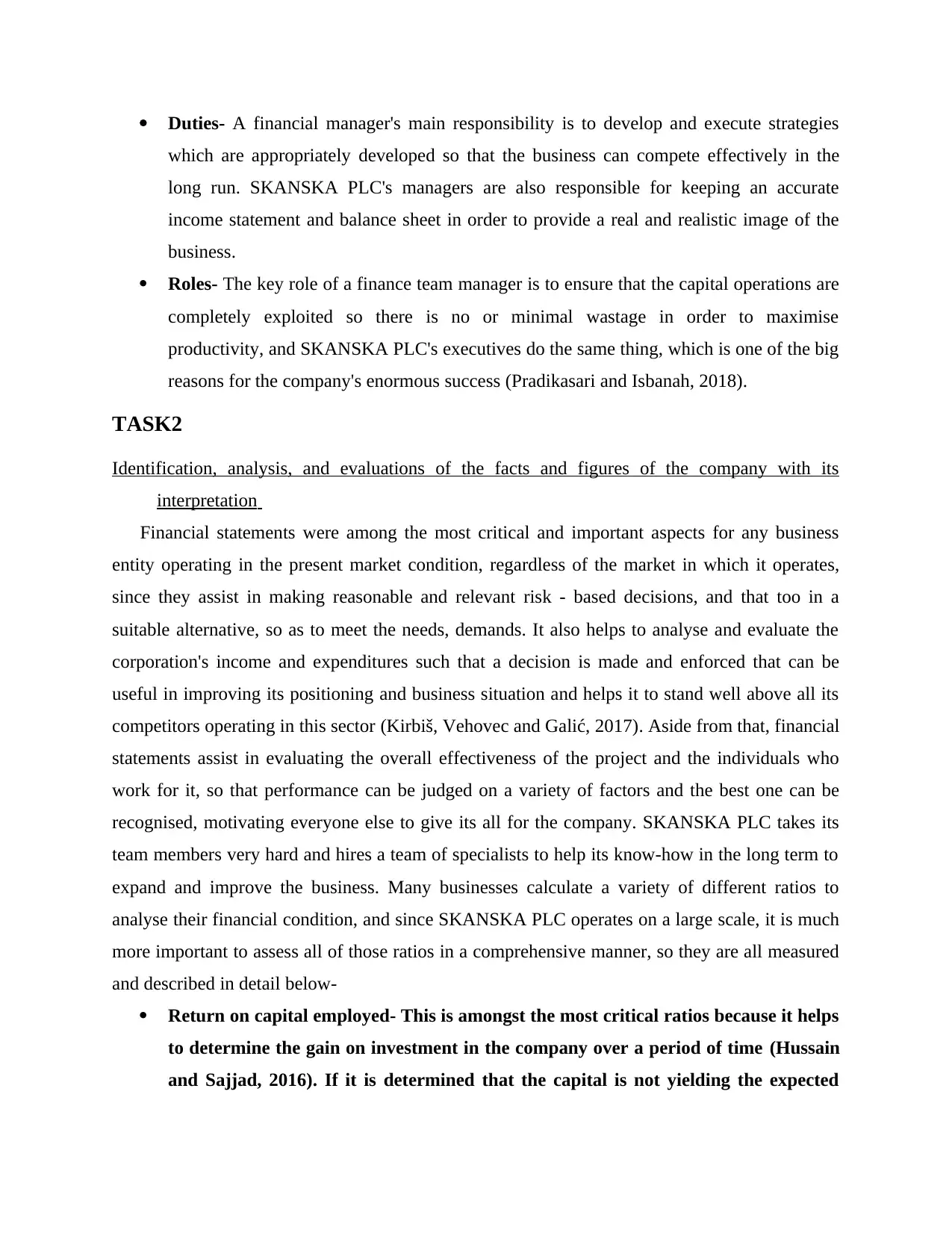
Duties- A financial manager's main responsibility is to develop and execute strategies
which are appropriately developed so that the business can compete effectively in the
long run. SKANSKA PLC's managers are also responsible for keeping an accurate
income statement and balance sheet in order to provide a real and realistic image of the
business.
Roles- The key role of a finance team manager is to ensure that the capital operations are
completely exploited so there is no or minimal wastage in order to maximise
productivity, and SKANSKA PLC's executives do the same thing, which is one of the big
reasons for the company's enormous success (Pradikasari and Isbanah, 2018).
TASK2
Identification, analysis, and evaluations of the facts and figures of the company with its
interpretation
Financial statements were among the most critical and important aspects for any business
entity operating in the present market condition, regardless of the market in which it operates,
since they assist in making reasonable and relevant risk - based decisions, and that too in a
suitable alternative, so as to meet the needs, demands. It also helps to analyse and evaluate the
corporation's income and expenditures such that a decision is made and enforced that can be
useful in improving its positioning and business situation and helps it to stand well above all its
competitors operating in this sector (Kirbiš, Vehovec and Galić, 2017). Aside from that, financial
statements assist in evaluating the overall effectiveness of the project and the individuals who
work for it, so that performance can be judged on a variety of factors and the best one can be
recognised, motivating everyone else to give its all for the company. SKANSKA PLC takes its
team members very hard and hires a team of specialists to help its know-how in the long term to
expand and improve the business. Many businesses calculate a variety of different ratios to
analyse their financial condition, and since SKANSKA PLC operates on a large scale, it is much
more important to assess all of those ratios in a comprehensive manner, so they are all measured
and described in detail below-
Return on capital employed- This is amongst the most critical ratios because it helps
to determine the gain on investment in the company over a period of time (Hussain
and Sajjad, 2016). If it is determined that the capital is not yielding the expected
which are appropriately developed so that the business can compete effectively in the
long run. SKANSKA PLC's managers are also responsible for keeping an accurate
income statement and balance sheet in order to provide a real and realistic image of the
business.
Roles- The key role of a finance team manager is to ensure that the capital operations are
completely exploited so there is no or minimal wastage in order to maximise
productivity, and SKANSKA PLC's executives do the same thing, which is one of the big
reasons for the company's enormous success (Pradikasari and Isbanah, 2018).
TASK2
Identification, analysis, and evaluations of the facts and figures of the company with its
interpretation
Financial statements were among the most critical and important aspects for any business
entity operating in the present market condition, regardless of the market in which it operates,
since they assist in making reasonable and relevant risk - based decisions, and that too in a
suitable alternative, so as to meet the needs, demands. It also helps to analyse and evaluate the
corporation's income and expenditures such that a decision is made and enforced that can be
useful in improving its positioning and business situation and helps it to stand well above all its
competitors operating in this sector (Kirbiš, Vehovec and Galić, 2017). Aside from that, financial
statements assist in evaluating the overall effectiveness of the project and the individuals who
work for it, so that performance can be judged on a variety of factors and the best one can be
recognised, motivating everyone else to give its all for the company. SKANSKA PLC takes its
team members very hard and hires a team of specialists to help its know-how in the long term to
expand and improve the business. Many businesses calculate a variety of different ratios to
analyse their financial condition, and since SKANSKA PLC operates on a large scale, it is much
more important to assess all of those ratios in a comprehensive manner, so they are all measured
and described in detail below-
Return on capital employed- This is amongst the most critical ratios because it helps
to determine the gain on investment in the company over a period of time (Hussain
and Sajjad, 2016). If it is determined that the capital is not yielding the expected
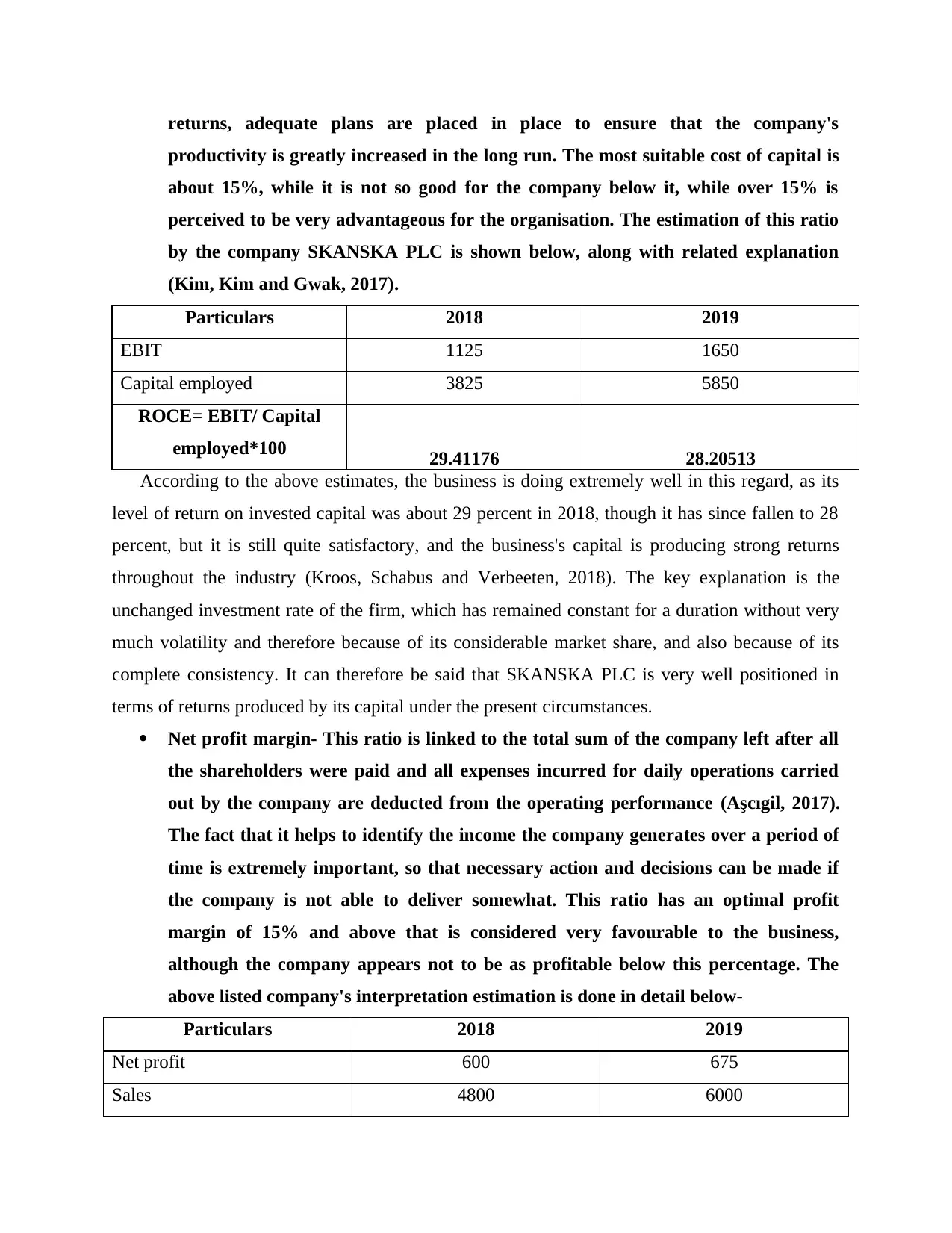
returns, adequate plans are placed in place to ensure that the company's
productivity is greatly increased in the long run. The most suitable cost of capital is
about 15%, while it is not so good for the company below it, while over 15% is
perceived to be very advantageous for the organisation. The estimation of this ratio
by the company SKANSKA PLC is shown below, along with related explanation
(Kim, Kim and Gwak, 2017).
Particulars 2018 2019
EBIT 1125 1650
Capital employed 3825 5850
ROCE= EBIT/ Capital
employed*100 29.41176 28.20513
According to the above estimates, the business is doing extremely well in this regard, as its
level of return on invested capital was about 29 percent in 2018, though it has since fallen to 28
percent, but it is still quite satisfactory, and the business's capital is producing strong returns
throughout the industry (Kroos, Schabus and Verbeeten, 2018). The key explanation is the
unchanged investment rate of the firm, which has remained constant for a duration without very
much volatility and therefore because of its considerable market share, and also because of its
complete consistency. It can therefore be said that SKANSKA PLC is very well positioned in
terms of returns produced by its capital under the present circumstances.
Net profit margin- This ratio is linked to the total sum of the company left after all
the shareholders were paid and all expenses incurred for daily operations carried
out by the company are deducted from the operating performance (Aşcıgil, 2017).
The fact that it helps to identify the income the company generates over a period of
time is extremely important, so that necessary action and decisions can be made if
the company is not able to deliver somewhat. This ratio has an optimal profit
margin of 15% and above that is considered very favourable to the business,
although the company appears not to be as profitable below this percentage. The
above listed company's interpretation estimation is done in detail below-
Particulars 2018 2019
Net profit 600 675
Sales 4800 6000
productivity is greatly increased in the long run. The most suitable cost of capital is
about 15%, while it is not so good for the company below it, while over 15% is
perceived to be very advantageous for the organisation. The estimation of this ratio
by the company SKANSKA PLC is shown below, along with related explanation
(Kim, Kim and Gwak, 2017).
Particulars 2018 2019
EBIT 1125 1650
Capital employed 3825 5850
ROCE= EBIT/ Capital
employed*100 29.41176 28.20513
According to the above estimates, the business is doing extremely well in this regard, as its
level of return on invested capital was about 29 percent in 2018, though it has since fallen to 28
percent, but it is still quite satisfactory, and the business's capital is producing strong returns
throughout the industry (Kroos, Schabus and Verbeeten, 2018). The key explanation is the
unchanged investment rate of the firm, which has remained constant for a duration without very
much volatility and therefore because of its considerable market share, and also because of its
complete consistency. It can therefore be said that SKANSKA PLC is very well positioned in
terms of returns produced by its capital under the present circumstances.
Net profit margin- This ratio is linked to the total sum of the company left after all
the shareholders were paid and all expenses incurred for daily operations carried
out by the company are deducted from the operating performance (Aşcıgil, 2017).
The fact that it helps to identify the income the company generates over a period of
time is extremely important, so that necessary action and decisions can be made if
the company is not able to deliver somewhat. This ratio has an optimal profit
margin of 15% and above that is considered very favourable to the business,
although the company appears not to be as profitable below this percentage. The
above listed company's interpretation estimation is done in detail below-
Particulars 2018 2019
Net profit 600 675
Sales 4800 6000
⊘ This is a preview!⊘
Do you want full access?
Subscribe today to unlock all pages.

Trusted by 1+ million students worldwide
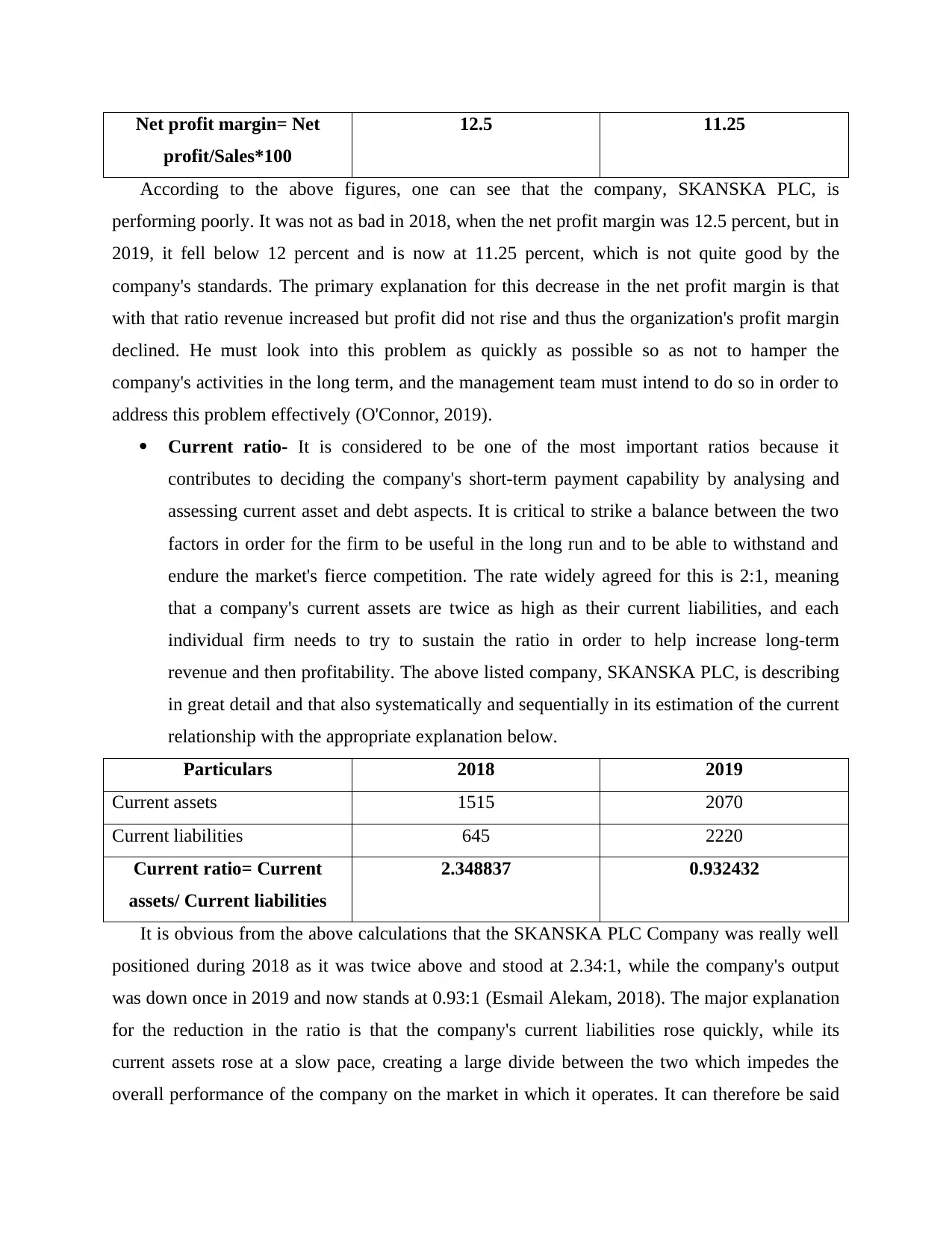
Net profit margin= Net
profit/Sales*100
12.5 11.25
According to the above figures, one can see that the company, SKANSKA PLC, is
performing poorly. It was not as bad in 2018, when the net profit margin was 12.5 percent, but in
2019, it fell below 12 percent and is now at 11.25 percent, which is not quite good by the
company's standards. The primary explanation for this decrease in the net profit margin is that
with that ratio revenue increased but profit did not rise and thus the organization's profit margin
declined. He must look into this problem as quickly as possible so as not to hamper the
company's activities in the long term, and the management team must intend to do so in order to
address this problem effectively (O'Connor, 2019).
Current ratio- It is considered to be one of the most important ratios because it
contributes to deciding the company's short-term payment capability by analysing and
assessing current asset and debt aspects. It is critical to strike a balance between the two
factors in order for the firm to be useful in the long run and to be able to withstand and
endure the market's fierce competition. The rate widely agreed for this is 2:1, meaning
that a company's current assets are twice as high as their current liabilities, and each
individual firm needs to try to sustain the ratio in order to help increase long-term
revenue and then profitability. The above listed company, SKANSKA PLC, is describing
in great detail and that also systematically and sequentially in its estimation of the current
relationship with the appropriate explanation below.
Particulars 2018 2019
Current assets 1515 2070
Current liabilities 645 2220
Current ratio= Current
assets/ Current liabilities
2.348837 0.932432
It is obvious from the above calculations that the SKANSKA PLC Company was really well
positioned during 2018 as it was twice above and stood at 2.34:1, while the company's output
was down once in 2019 and now stands at 0.93:1 (Esmail Alekam, 2018). The major explanation
for the reduction in the ratio is that the company's current liabilities rose quickly, while its
current assets rose at a slow pace, creating a large divide between the two which impedes the
overall performance of the company on the market in which it operates. It can therefore be said
profit/Sales*100
12.5 11.25
According to the above figures, one can see that the company, SKANSKA PLC, is
performing poorly. It was not as bad in 2018, when the net profit margin was 12.5 percent, but in
2019, it fell below 12 percent and is now at 11.25 percent, which is not quite good by the
company's standards. The primary explanation for this decrease in the net profit margin is that
with that ratio revenue increased but profit did not rise and thus the organization's profit margin
declined. He must look into this problem as quickly as possible so as not to hamper the
company's activities in the long term, and the management team must intend to do so in order to
address this problem effectively (O'Connor, 2019).
Current ratio- It is considered to be one of the most important ratios because it
contributes to deciding the company's short-term payment capability by analysing and
assessing current asset and debt aspects. It is critical to strike a balance between the two
factors in order for the firm to be useful in the long run and to be able to withstand and
endure the market's fierce competition. The rate widely agreed for this is 2:1, meaning
that a company's current assets are twice as high as their current liabilities, and each
individual firm needs to try to sustain the ratio in order to help increase long-term
revenue and then profitability. The above listed company, SKANSKA PLC, is describing
in great detail and that also systematically and sequentially in its estimation of the current
relationship with the appropriate explanation below.
Particulars 2018 2019
Current assets 1515 2070
Current liabilities 645 2220
Current ratio= Current
assets/ Current liabilities
2.348837 0.932432
It is obvious from the above calculations that the SKANSKA PLC Company was really well
positioned during 2018 as it was twice above and stood at 2.34:1, while the company's output
was down once in 2019 and now stands at 0.93:1 (Esmail Alekam, 2018). The major explanation
for the reduction in the ratio is that the company's current liabilities rose quickly, while its
current assets rose at a slow pace, creating a large divide between the two which impedes the
overall performance of the company on the market in which it operates. It can therefore be said
Paraphrase This Document
Need a fresh take? Get an instant paraphrase of this document with our AI Paraphraser
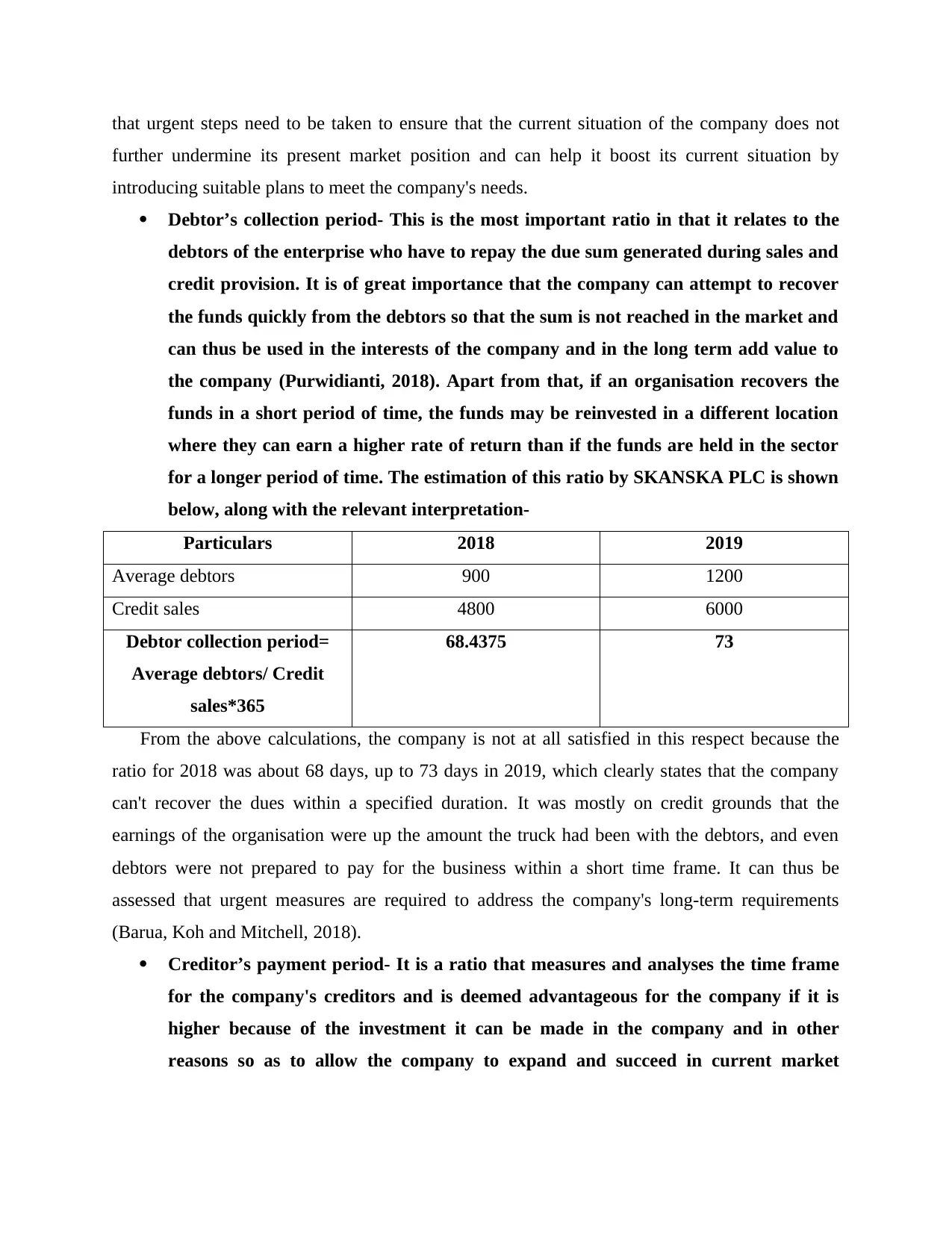
that urgent steps need to be taken to ensure that the current situation of the company does not
further undermine its present market position and can help it boost its current situation by
introducing suitable plans to meet the company's needs.
Debtor’s collection period- This is the most important ratio in that it relates to the
debtors of the enterprise who have to repay the due sum generated during sales and
credit provision. It is of great importance that the company can attempt to recover
the funds quickly from the debtors so that the sum is not reached in the market and
can thus be used in the interests of the company and in the long term add value to
the company (Purwidianti, 2018). Apart from that, if an organisation recovers the
funds in a short period of time, the funds may be reinvested in a different location
where they can earn a higher rate of return than if the funds are held in the sector
for a longer period of time. The estimation of this ratio by SKANSKA PLC is shown
below, along with the relevant interpretation-
Particulars 2018 2019
Average debtors 900 1200
Credit sales 4800 6000
Debtor collection period=
Average debtors/ Credit
sales*365
68.4375 73
From the above calculations, the company is not at all satisfied in this respect because the
ratio for 2018 was about 68 days, up to 73 days in 2019, which clearly states that the company
can't recover the dues within a specified duration. It was mostly on credit grounds that the
earnings of the organisation were up the amount the truck had been with the debtors, and even
debtors were not prepared to pay for the business within a short time frame. It can thus be
assessed that urgent measures are required to address the company's long-term requirements
(Barua, Koh and Mitchell, 2018).
Creditor’s payment period- It is a ratio that measures and analyses the time frame
for the company's creditors and is deemed advantageous for the company if it is
higher because of the investment it can be made in the company and in other
reasons so as to allow the company to expand and succeed in current market
further undermine its present market position and can help it boost its current situation by
introducing suitable plans to meet the company's needs.
Debtor’s collection period- This is the most important ratio in that it relates to the
debtors of the enterprise who have to repay the due sum generated during sales and
credit provision. It is of great importance that the company can attempt to recover
the funds quickly from the debtors so that the sum is not reached in the market and
can thus be used in the interests of the company and in the long term add value to
the company (Purwidianti, 2018). Apart from that, if an organisation recovers the
funds in a short period of time, the funds may be reinvested in a different location
where they can earn a higher rate of return than if the funds are held in the sector
for a longer period of time. The estimation of this ratio by SKANSKA PLC is shown
below, along with the relevant interpretation-
Particulars 2018 2019
Average debtors 900 1200
Credit sales 4800 6000
Debtor collection period=
Average debtors/ Credit
sales*365
68.4375 73
From the above calculations, the company is not at all satisfied in this respect because the
ratio for 2018 was about 68 days, up to 73 days in 2019, which clearly states that the company
can't recover the dues within a specified duration. It was mostly on credit grounds that the
earnings of the organisation were up the amount the truck had been with the debtors, and even
debtors were not prepared to pay for the business within a short time frame. It can thus be
assessed that urgent measures are required to address the company's long-term requirements
(Barua, Koh and Mitchell, 2018).
Creditor’s payment period- It is a ratio that measures and analyses the time frame
for the company's creditors and is deemed advantageous for the company if it is
higher because of the investment it can be made in the company and in other
reasons so as to allow the company to expand and succeed in current market
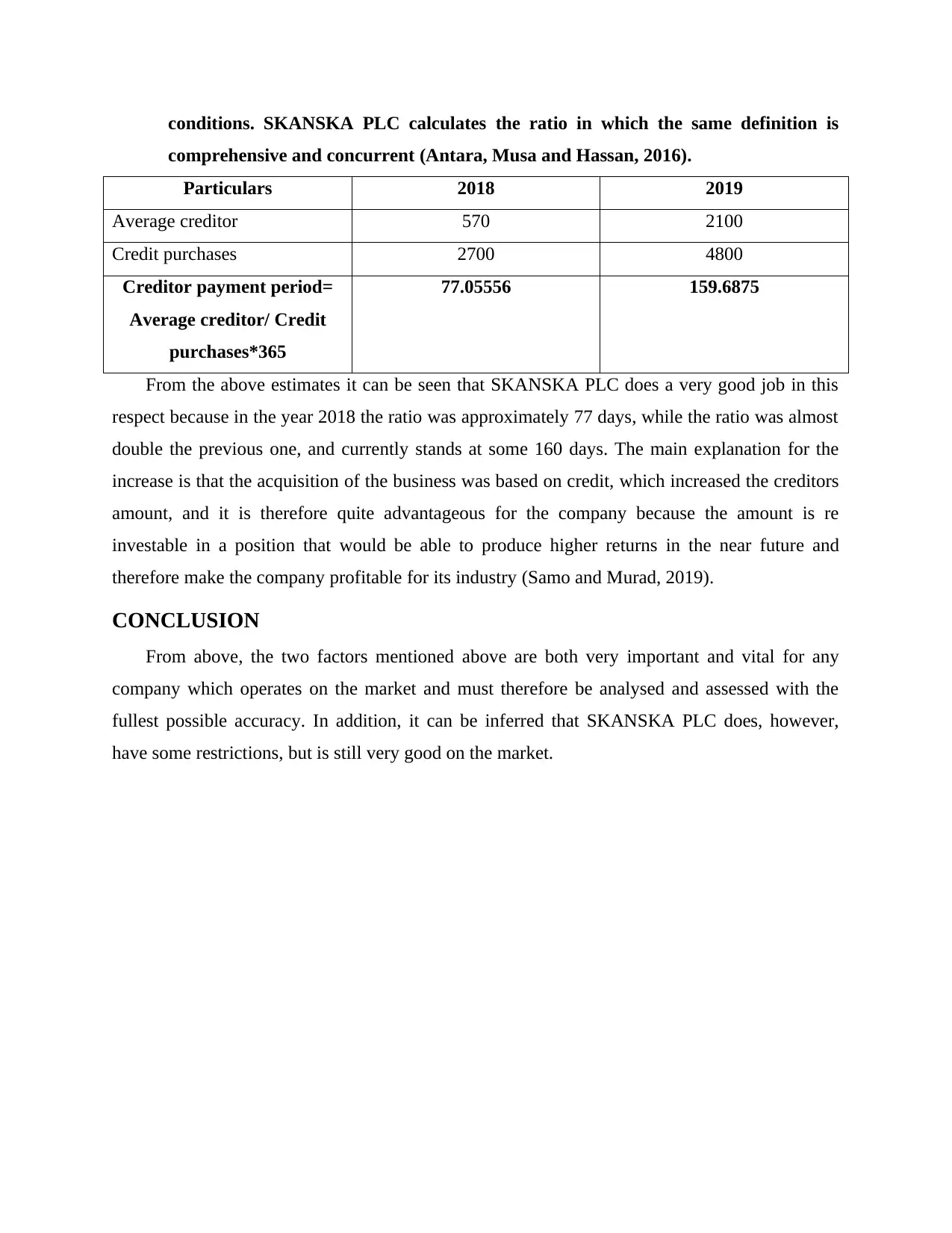
conditions. SKANSKA PLC calculates the ratio in which the same definition is
comprehensive and concurrent (Antara, Musa and Hassan, 2016).
Particulars 2018 2019
Average creditor 570 2100
Credit purchases 2700 4800
Creditor payment period=
Average creditor/ Credit
purchases*365
77.05556 159.6875
From the above estimates it can be seen that SKANSKA PLC does a very good job in this
respect because in the year 2018 the ratio was approximately 77 days, while the ratio was almost
double the previous one, and currently stands at some 160 days. The main explanation for the
increase is that the acquisition of the business was based on credit, which increased the creditors
amount, and it is therefore quite advantageous for the company because the amount is re
investable in a position that would be able to produce higher returns in the near future and
therefore make the company profitable for its industry (Samo and Murad, 2019).
CONCLUSION
From above, the two factors mentioned above are both very important and vital for any
company which operates on the market and must therefore be analysed and assessed with the
fullest possible accuracy. In addition, it can be inferred that SKANSKA PLC does, however,
have some restrictions, but is still very good on the market.
comprehensive and concurrent (Antara, Musa and Hassan, 2016).
Particulars 2018 2019
Average creditor 570 2100
Credit purchases 2700 4800
Creditor payment period=
Average creditor/ Credit
purchases*365
77.05556 159.6875
From the above estimates it can be seen that SKANSKA PLC does a very good job in this
respect because in the year 2018 the ratio was approximately 77 days, while the ratio was almost
double the previous one, and currently stands at some 160 days. The main explanation for the
increase is that the acquisition of the business was based on credit, which increased the creditors
amount, and it is therefore quite advantageous for the company because the amount is re
investable in a position that would be able to produce higher returns in the near future and
therefore make the company profitable for its industry (Samo and Murad, 2019).
CONCLUSION
From above, the two factors mentioned above are both very important and vital for any
company which operates on the market and must therefore be analysed and assessed with the
fullest possible accuracy. In addition, it can be inferred that SKANSKA PLC does, however,
have some restrictions, but is still very good on the market.
⊘ This is a preview!⊘
Do you want full access?
Subscribe today to unlock all pages.

Trusted by 1+ million students worldwide
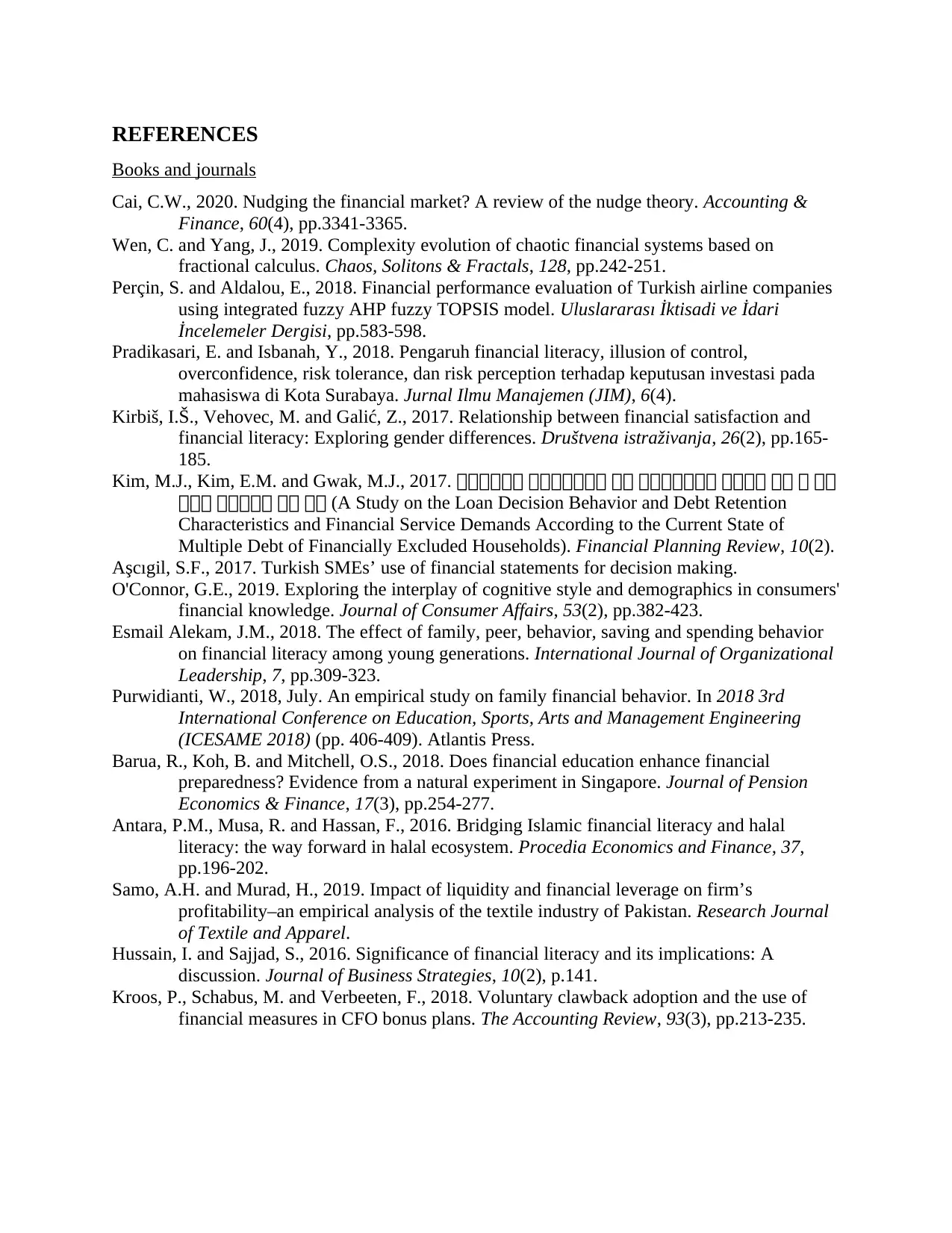
REFERENCES
Books and journals
Cai, C.W., 2020. Nudging the financial market? A review of the nudge theory. Accounting &
Finance, 60(4), pp.3341-3365.
Wen, C. and Yang, J., 2019. Complexity evolution of chaotic financial systems based on
fractional calculus. Chaos, Solitons & Fractals, 128, pp.242-251.
Perçin, S. and Aldalou, E., 2018. Financial performance evaluation of Turkish airline companies
using integrated fuzzy AHP fuzzy TOPSIS model. Uluslararası İktisadi ve İdari
İncelemeler Dergisi, pp.583-598.
Pradikasari, E. and Isbanah, Y., 2018. Pengaruh financial literacy, illusion of control,
overconfidence, risk tolerance, dan risk perception terhadap keputusan investasi pada
mahasiswa di Kota Surabaya. Jurnal Ilmu Manajemen (JIM), 6(4).
Kirbiš, I.Š., Vehovec, M. and Galić, Z., 2017. Relationship between financial satisfaction and
financial literacy: Exploring gender differences. Društvena istraživanja, 26(2), pp.165-
185.
Kim, M.J., Kim, E.M. and Gwak, M.J., 2017. 금금금금금금 금금금금금금금 금금 금금금금금금금 금금금금 금금 금 금금
금금금 금금금금금 금금 금금 (A Study on the Loan Decision Behavior and Debt Retention
Characteristics and Financial Service Demands According to the Current State of
Multiple Debt of Financially Excluded Households). Financial Planning Review, 10(2).
Aşcıgil, S.F., 2017. Turkish SMEs’ use of financial statements for decision making.
O'Connor, G.E., 2019. Exploring the interplay of cognitive style and demographics in consumers'
financial knowledge. Journal of Consumer Affairs, 53(2), pp.382-423.
Esmail Alekam, J.M., 2018. The effect of family, peer, behavior, saving and spending behavior
on financial literacy among young generations. International Journal of Organizational
Leadership, 7, pp.309-323.
Purwidianti, W., 2018, July. An empirical study on family financial behavior. In 2018 3rd
International Conference on Education, Sports, Arts and Management Engineering
(ICESAME 2018) (pp. 406-409). Atlantis Press.
Barua, R., Koh, B. and Mitchell, O.S., 2018. Does financial education enhance financial
preparedness? Evidence from a natural experiment in Singapore. Journal of Pension
Economics & Finance, 17(3), pp.254-277.
Antara, P.M., Musa, R. and Hassan, F., 2016. Bridging Islamic financial literacy and halal
literacy: the way forward in halal ecosystem. Procedia Economics and Finance, 37,
pp.196-202.
Samo, A.H. and Murad, H., 2019. Impact of liquidity and financial leverage on firm’s
profitability–an empirical analysis of the textile industry of Pakistan. Research Journal
of Textile and Apparel.
Hussain, I. and Sajjad, S., 2016. Significance of financial literacy and its implications: A
discussion. Journal of Business Strategies, 10(2), p.141.
Kroos, P., Schabus, M. and Verbeeten, F., 2018. Voluntary clawback adoption and the use of
financial measures in CFO bonus plans. The Accounting Review, 93(3), pp.213-235.
Books and journals
Cai, C.W., 2020. Nudging the financial market? A review of the nudge theory. Accounting &
Finance, 60(4), pp.3341-3365.
Wen, C. and Yang, J., 2019. Complexity evolution of chaotic financial systems based on
fractional calculus. Chaos, Solitons & Fractals, 128, pp.242-251.
Perçin, S. and Aldalou, E., 2018. Financial performance evaluation of Turkish airline companies
using integrated fuzzy AHP fuzzy TOPSIS model. Uluslararası İktisadi ve İdari
İncelemeler Dergisi, pp.583-598.
Pradikasari, E. and Isbanah, Y., 2018. Pengaruh financial literacy, illusion of control,
overconfidence, risk tolerance, dan risk perception terhadap keputusan investasi pada
mahasiswa di Kota Surabaya. Jurnal Ilmu Manajemen (JIM), 6(4).
Kirbiš, I.Š., Vehovec, M. and Galić, Z., 2017. Relationship between financial satisfaction and
financial literacy: Exploring gender differences. Društvena istraživanja, 26(2), pp.165-
185.
Kim, M.J., Kim, E.M. and Gwak, M.J., 2017. 금금금금금금 금금금금금금금 금금 금금금금금금금 금금금금 금금 금 금금
금금금 금금금금금 금금 금금 (A Study on the Loan Decision Behavior and Debt Retention
Characteristics and Financial Service Demands According to the Current State of
Multiple Debt of Financially Excluded Households). Financial Planning Review, 10(2).
Aşcıgil, S.F., 2017. Turkish SMEs’ use of financial statements for decision making.
O'Connor, G.E., 2019. Exploring the interplay of cognitive style and demographics in consumers'
financial knowledge. Journal of Consumer Affairs, 53(2), pp.382-423.
Esmail Alekam, J.M., 2018. The effect of family, peer, behavior, saving and spending behavior
on financial literacy among young generations. International Journal of Organizational
Leadership, 7, pp.309-323.
Purwidianti, W., 2018, July. An empirical study on family financial behavior. In 2018 3rd
International Conference on Education, Sports, Arts and Management Engineering
(ICESAME 2018) (pp. 406-409). Atlantis Press.
Barua, R., Koh, B. and Mitchell, O.S., 2018. Does financial education enhance financial
preparedness? Evidence from a natural experiment in Singapore. Journal of Pension
Economics & Finance, 17(3), pp.254-277.
Antara, P.M., Musa, R. and Hassan, F., 2016. Bridging Islamic financial literacy and halal
literacy: the way forward in halal ecosystem. Procedia Economics and Finance, 37,
pp.196-202.
Samo, A.H. and Murad, H., 2019. Impact of liquidity and financial leverage on firm’s
profitability–an empirical analysis of the textile industry of Pakistan. Research Journal
of Textile and Apparel.
Hussain, I. and Sajjad, S., 2016. Significance of financial literacy and its implications: A
discussion. Journal of Business Strategies, 10(2), p.141.
Kroos, P., Schabus, M. and Verbeeten, F., 2018. Voluntary clawback adoption and the use of
financial measures in CFO bonus plans. The Accounting Review, 93(3), pp.213-235.
1 out of 10
Related Documents
Your All-in-One AI-Powered Toolkit for Academic Success.
+13062052269
info@desklib.com
Available 24*7 on WhatsApp / Email
![[object Object]](/_next/static/media/star-bottom.7253800d.svg)
Unlock your academic potential
Copyright © 2020–2025 A2Z Services. All Rights Reserved. Developed and managed by ZUCOL.





